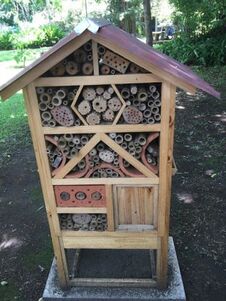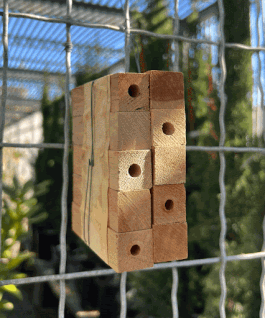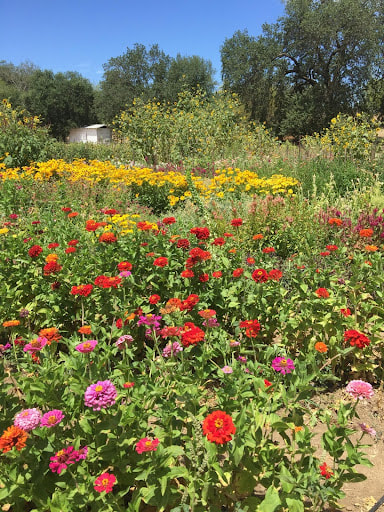 Introduction The model of a ‘Bee Hotel’ has been a useful tool for surveying insects in research studies for decades. However, in recent years, the concept of a bee hotel has entered the mainstream; capturing the attention of naturalists, gardeners, and those alike. With this transition, it has gained its name and evolved to take on various forms that hardly resemble the humble wooden box model used in research. Increased interest in creating spaces for bees is hopeful, as it signifies a positive trend in attention to pollinator livelihood. The UC Berkeley Urban Bee Lab has had great success with simplistic wooden box models of bee hotels in our Costa Rica Bee Project. We share here some of the knowledge we have gained through numerous years of research working with bee hotels in both Costa Rica and California. Additionally, we offer some considerations when creating your own bee hotel, acknowledging the limitations that they hold, especially in regards to a changing climate. The Bee Story Bee hotels offer a straightforward method of surveying cavity-nesting bee populations. This approach of surveying insects has been around for many decades, as the wooden-box model was described in the 1967 book, “Trap-nesting wasps and bees: life histories, nests, and associates”. Through the use of bee hotels in our Costa Rica Project, we were able to gain considerable insight into seasonality, emergence, and patterns of nesting preference. We attribute much of our success in this project to our commitment to mimicking natural conditions of cavity-nesting* bee habitats. Our personal model of a bee hotel is a simple wooden block with at least 3 inch holes drilled inside. Additionally, we scatter our models widely to be consistent with patterns observed in natural settings. Scattering the models aids in reducing the risk of predators or parasites, as opposed to clustering cavities together, which in turn could create a ‘buffet’ for predators and parasites. Left: An example of an artistic display of a bee hotel in Costa Rica.  Left: Wooden box model used in the Urban Bee Lab Costa Rica Project. Considerations By implementing bee hotels in our Costa Rica Project, we observed a significant abundance of bee hotel occupants. However, it is important to acknowledge that these observations come from a time when the effects of anthropogenic climate change were not nearly as pronounced. While we support that mimicking natural conditions is in part attributable to the great number of cavity-nesting bees observed in our bee hotels, we speculate that if this study was recreated today there would be considerably fewer bee occupants due to the extensive decline in species since then. Around the world, ecosystems are under threat due to the velocity of climate change. A vast number of insect species are collapsing at an alarming rate, which could reap devastating consequences as described recently by Milman in, “The Insect Crisis: The Fall of the Tiny Empires that Run the World”. In California, longer periods of drought and increased temperatures are contributing to a tremendous loss of biodiversity. In combination with a reduction in species diversity, unusual climatic phenomena are impacting the phenology of a number of bee species. A study published in 2018 conducted an analysis on the effects of warming on Osmia ribifloris**. It was found that experimental warming resulted in a greater variation in emergence times of O. ribifloris, with an overall trend in delayed emergence (CaraDonna et. al, 2018). On a broader scale, fewer bee species have been recorded since the 1950s with an alarmingly sharp decline of bee species from 2006 to 2015 with approximately 25% fewer species recorded (Zattara & Aizen, 2021). Both findings are consistent with observations we have made in the field. What does this have to do with Bee Hotels? Other Hotel Guests With a reduction in species diversity, there are overall fewer bees to occupy bee hotels leaving a vacancy to be filled by other inhabitants. As we have observed in the field, hotel guests can include: ants, spiders, wasps, earwigs, crickets (and even small frogs as we have seen in our Costa Rica Project!). Caution in Cleaning out Hotels Many often choose to clean out their bee hotels after a year of use to make room for new occupants. However, with the recent trends of delayed emergence in mind, as well as the potential for other inhabitants, it is important to check inside your bee hotel before cleaning it out. Potential Alternative: The Bee Garden Bee gardens create habitat for all varieties of bee species. By contrast, bee hotels can only be of use for cavity-nesting bees, which make up a much smaller percentage of the bee species in an area (roughly 30%). Bee hotels can be beneficial by providing habitat for cavity-nesters, but their effectiveness is not nearly as great, or proven as bee gardens. We have found bee gardens to be successful in attracting a wide range of bee species. In Ukiah (northern CA), we sampled bees over 2 years in 2007 and 2008 in a small residential garden that fortuitously had diverse bee plants. We also added some known bee-attractive plants to the garden. The sample yielded 68 bee species; city wide 91 bee species were known. Here at UC Berkeley, we built a diverse pollinator habitat garden in an open bare dirt field at the UC Berkeley Oxford Tract. After a few years of plant growth and development, we sampled the garden for bee species. The sample yielded about 65 native bee species. If you are someone who is interested in contributing to the preservation of native bee populations, planting a bee garden may be a more viable option. Considering the established effectiveness of bee gardens, we prefer them over bee hotels or in conjunction with. If you are planning to build a bee garden in your own yard, we encourage you to pack in plant species that have proven to attract bees and encourage that the bigger the garden the better! Above: The image is of a large urban garden in Brentwood (Contra Costa Co.) CA. Our Recommendation: Being mindful of the consideration and limitations of bee hotels is essential to ensuring that they help bee species, rather than cause harm. As noted before, we encourage sticking to a simple model, ensuring that the holes are deep enough (3+ inches) and scattering bee hotels rather than clustering them together. While artistic displays can be attractive, they are not necessarily effective. Our personal approach is to avoid cleaning out hotels completely. Rather, we relocate them to a preferably wild area where natural elements can take over and reuse the holes; or where late emergers can take their time to emerge over perhaps more than one year. If you are eager to clean out your bee hotel, we strongly recommend taking a look inside using an LED light before doing so as there may still be occupants! *Bee species that lay their eggs and nest in hollowed out chambers of wood. ** A cavity-nesting bee species that is found throughout the Western and Southwestern United States. Helpful Articles: http://www.helpabee.org/seasonal-bee-gardening.html http://www.helpabee.org/best-bee-plants-for-california.html References CaraDonna, P. J., Cunningham, J. L., & Iler, A. M. (2018). Experimental warming in the field delays phenology and reduces body mass, fat content and survival: Implications for the persistence of a pollinator under climate change. Functional Ecology, 32(10), 2345–2356. https://doi.org/10.1111/1365-2435.13151 Frankie, G.W., R.W. Thorp, J.C. Pawelek, J. Hernandez, and R.Coville. (2009). Urban Bee Diversity in a Small Residential Garden in Northern California. Jour. Hymenoptera Research. 18(2): 368-379. Zattara, E. E., & Aizen, M. A. (2021). Worldwide occurrence records suggest a global decline in bee species richness. One Earth, 4(1), 114–123. https://doi.org/10.1016/j.oneear.2020.12.005 Krombein, K. V., & Krombein, K. V. (1967). Trap-nesting wasps and bees: Life histories, nests, and Associates. Smithsonian Press. Packer, L. (2023). Bees of the world: A guide to every family (guide to every family, 5). Princeton University Press. Milman, O. (2023b). The Insect Crisis: The Fall of the Tiny Empires that Run the World. W.W. Norton & Company. Nesting Resources. Xerces Society. (n.d.). https://xerces.org/pollinator-conservation/nesting-resources#:~:text=Cavity%20Nesting%20Bees,pieces%20of%20bamboo%20for%20nesting. Written by: Emma Coflin emma040521134@berkeley.edu
0 Comments
|
Details
Archives
December 2023
Categories |

 RSS Feed
RSS Feed
